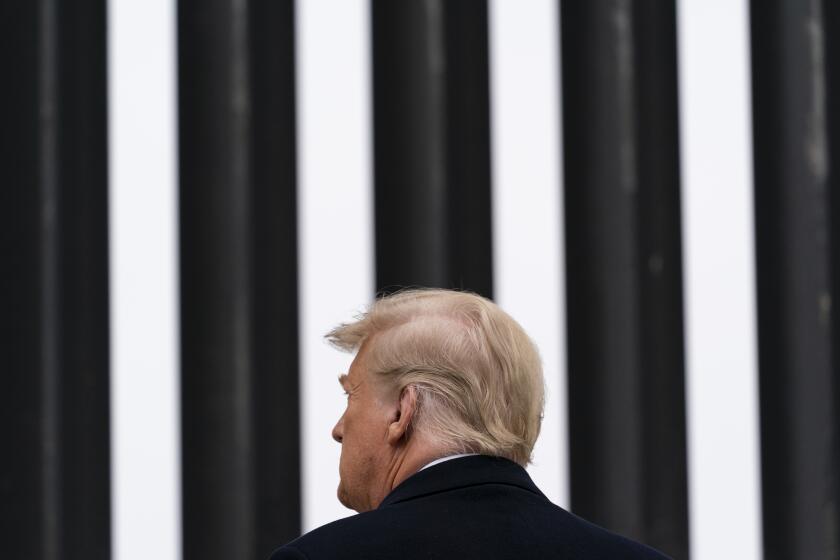Tim Rutten: Cardinal Mahony and the city he shaped
When the social and political history of Los Angeles in the late 20th century comes to be written, it’s likely that two men will stand out as fundamentally transformative leaders. One will be Tom Bradley, the five-term mayor who changed the city’s politics and realigned its economic course; the other will be Cardinal Roger Mahony, the Hollywood-born prelate who has led what is now America’s largest Roman Catholic diocese as archbishop for the last quarter-century, a post from which he will retire Sunday on his 75th birthday, as church law requires.
When Mahony returned to Los Angeles as archbishop in 1985, he inherited a sprawling archdiocese that was, internally, in disarray. Some of that was the lingering legacy of Cardinal James Francis McIntyre, whose ultra-reactionary temperament colored his views of both politics and the reforms of the Second Vatican Council. Some was the legacy of Mahony’s immediate predecessor, Cardinal Timothy Manning, who, though beloved for his spirituality, was an indifferent administrator who often appeared puzzled by popular culture and left his see all but bankrupt.
All that changed during Mahony’s tenure, as the archdiocese engaged issues from immigration to labor organizing and the living wage to the morality of nuclear deterrence, as well as capital punishment, abortion and political ethics. Today, the archdiocese is known among Catholics for the contemporary vibrancy of its liturgy and the breadth and depth of lay Catholics’ participation in church life. The archdiocese’s finances were robust enough to survive a $660-million settlement with victims of sexually abusive clerics without substantially undermining essential educational and social welfare programs.
Still, just as views of Bradley’s exit from public service inevitably were colored by the allegations of indifference to corruption among his cronies during his final term, appraisals of Mahony’s legacy are, at least for now, bound to be refracted through the international clerical abuse scandal in which the overwhelming majority of prelates of his generation have been caught up.
I recently spoke to Mahony about his 25 years as archbishop. Looking back on his life as a young priest, Mahony points out how fundamentally his outlook was shaped by his first bishop’s unexpected directive that, immediately after ordination, he study for a master’s degree in social work at Catholic University, as well as by his subsequent involvement as a priest and bishop with Cesar Chavez and the United Farm Workers.
“I don’t know what I would have done without the background and intellectual formation I received from studying social work,” he says. He also recalls “the impact of Cesar Chavez — the example of his nonviolence and his insistence on everything the union did coming from a moral and ethical principle rather than just a political strategy.”
In Los Angeles, simple numbers will amplify Mahony’s legacy. “When I arrived here, the Catholic population was about 24% of the three counties we serve,” he said. “Today we are about 50% of greater Los Angeles’ total population. The growth is primarily from immigration, and while at least 70% of our Catholic population is Hispanic, we also have 800,000 Filipinos and large numbers of Koreans, Vietnamese and, increasingly, Chinese.” The cardinal believes that the immigrants have enriched Catholic life by restoring “a sense of family’s importance and a cultural respect for personal spirituality that, maybe, had begun to decline among Anglo Catholics.”
He’s also proud of the archdiocese’s ability to provide $8 million a year in tuition subsidies to as many as 7,000 Catholic school students, and of a program that allows more-affluent parishes to contribute to poorer churches.
Similarly, Mahony points with pleasure to the role the Cathedral of Our Lady of the Angels has come to play in civic life. “What I really value,” he says, “is the way it has become a house of prayer for all peoples of all faiths. We wanted it to be a sacred space for all Los Angeles, where people can gather in happy and sad times, as with the funerals for police and firemen.”
When it comes to the expansive new role the laity plays in all phases of the archdiocese’s life, the cardinal insists it’s more than simply an adaptation to the decline in clerical vocations. “My personal high point probably would be the empowerment of lay people to really step forward and bring their gifts into service, particularly the women.”
Regarding the clerical abuse scandal, Mahony recognized that the crisis could not be complete until he began meeting with the victims. When he did, “I realized the absolute devastation, the long-lasting devastation, these victims had suffered…. I had no idea how deeply and permanently it affected people until I met with the victims.”
Next: More on the deeply personal way in which Mahony came to terms with the sex-abuse scandal’s implications and why he opposes denying communion to elected officials out of step with church teachings.
More to Read
A cure for the common opinion
Get thought-provoking perspectives with our weekly newsletter.
You may occasionally receive promotional content from the Los Angeles Times.










